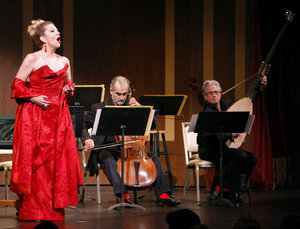
W e singers tend to boast that our careers offer the best form of psychotherapy in existence, for we are allowed to work out the bulk of our inner demons courtesy of the larger-than-life drama queens we encounter on the stage—divine ladies who weep, love, moan, and avenge more grandly and stylishly than in any other art form.”
— Joyce DiDonato, 2012.
T he Joyce DiDonato/Dmitry Sinkovsky/Il Complesso Barocco performance last night in the Harriman-Jewell Series was really phenomenal. Many extraordinary, seldom-heard works by lesser-known Baroque composers, like Antonio Cesti (1623-1669), Geminiano Giacomelli (1692-1740), Giuseppe Orlandini (1676-1760), and Giovanni Porta (1675-1755). Extraordinarily dramatic and vivid vocal and instrumental interpretations. Extraordinarily tight and responsive interactions between the ensemble members and Ms. DiDonato throughout.
A scending cadences, each with the forte dynamic they require, imparting a strong sense of closure. Descending cadences to pianissimo, imparting a sense of sorrow with aspiration. The sort of gestures that Hatten once characterized as “yearning” (see links below).
F ormalized emotion—a dialectic of ‘drama queens’—DiDonato rations her body movement, reserves it mostly for recitative passages, while her body is relatively still during arias: her regal rhetoric is well-suited to these stories of queens and princesses. The arias ‘frame’ the dramatic recitatives, not the other way round (that is, ‘decorative’ arias, see Taruskin, p. 25).
M ost online reviews from performances on their current tour do focus, understandably, on Ms. DiDonato’s singing. But, my God, this ensemble! Gorgeous! And, my God, Sinkovsky! Prodigious!
W hat strings is Dmitry Sinkovsky playing!!? Silver-plated, copper on gut? Pirastro Eudoxa? Chorda? Sensuous with a glint, a sound that is a perfect match for DiDonato's rich mezzo-soprano voice!
T he wound G-string was common on violins in the 18th century. Beyond 1840 and already far beyond plain gut strings, composers were writing things that were, essentially, only playable with a wound G string. With modern strings, we’d lose this rich, complex sound of very thick gut strings. We’d lose the consort timbre within the violin family. We’d lose the diversity of articulation, and we’d lose subtleties of this 17th and 18th Century sonic architecture.
T o a software engineer like me, the musical score is an object-oriented ‘method’, procedural code executed on an instance of an object-class that may or may not grant all of the behaviors specified by the arguments passed to it. But Dmitry Sinkovsky and Il Complesso Barocco accomodate all args, all flavors!
T he range of Dmitry Sinkovsky’s articulation is especially interesting, because it allows him to imitate the singer’s diction, with diverse ‘consonants’ beginning each violin-syllable (or bow stroke) and diverse glottal and quasi-labial and -dental and -fricative sounds to match each of DiDonato’s vocal gestures. Through the centuries, the imitation of the human voice has always been an ardently sought goal for instrumentalists. Sinkovsky totally owns this! (He has even mastered American folk-fiddlish, jiggy “hoe-down” technic, which he improvised to humorous effect at DiDonato’s prompting for one of her encores, to the raucous delight of her hometown Kansas City audience!)
S inkovsky’s pulsatile, fluid bow-and-whole-body gestures, dance-like, match DiDonato’s operatic arms-and-whole-body gestures. Sinkovsky’s bow stroke is Transitional Period? Russian? Energized ‘non-legato’, at any rate! Because of the ‘give’ of the bowhair, the bow does not emit full sound immediately at the onset of the stroke, but only after some pressure has been exerted and some bow excursion has occurred—the momentary softness followed by a crescendo in each stroke.
H e plays fast passages with energy abounding but with still a roundness to his sound and supple articulations. A player trained in a modern, pressure-on-the-bowstick style feels immediately that baroque bow does not give the attack of a modern bow—it’s more from the wrist and fingers. But Sinkovsky’s Baroque bow attack is astonishingly sharp—more so maybe than would be achieved with a modern bow. Our jaws were agog for 2 hours in gob-smacked amazement.
A re these tempi faster than normal, or are we just glad to see you all? Was the room hot, or was it just you? :)
N ext up for these artists is Carnegie Hall tomorrow.
- Joyce DiDonato website.
- DiDonato & Il Complesso Barocco. Drama Queens. (Virgin Records, 2012.)
- Dmitry Sinkovsky page at Andreas Janotta Arts Management.
- Il Complesso Barocco website.
- Bachtrack blog. DiDonato Drama Queens review. 14-NOV-2012.
- Burton A. Performer's Guide to Music of the Baroque Period. Oxford Univ, 2001.
- Clement C, Wing B, McClary S. Opera; or, The Undoing of Women. Univ Minnesota, 1999.
- Conrad P. A Song of Love and Death: The Meaning of Opera. Poseidon, 1988.
- Fubini E. Music and Culture in Eighteenth-Century Europe: A Source Book. Univ Chicago, 1994.
- Goldenberg Y. A musical gesture of growing obstinacy. MTO 2006;12(2).
- Hatten R. Musical Meaning. Indiana Univ, 2004. p. 100.
- Hatten R. Interpreting Musical Gestures. Indiana Univ, 2004.
- Heurtz J. Joyce DiDonato returns in triumphant Folly concert. Kansas City Star, 17-NOV-2012.
- Kerman J. Opera as Drama. Univ California, 2005.
- Kivy P. Osmin's Rage: Philosophical Reflections on Opera, Drama, and Text. Princeton Univ, 1988.
- McClintock C, ed. The Solo Song, 1580-1730. Norton, 1973.
- Morrison M. Joyce DiDonato Drama Queens review. The Times. 03-NOV-2012.
- Robinson P. Opera, Sex, and Other Matters. Univ Chicago, 2002.
- Rosenberg M. Drama Queens review. WQXR, 11-NOV-2012.
- Rutherford S. The Prima Donna and Opera, 1815-1930. Cambridge Univ, 2006.
- Taruskin R. Music in the Seventeenth and Eighteenth Centuries. Oxford Univ, 2009.
- Baroque violin strings at EarlyMusicShop
- Baroque violin strings at TheStringZone
No comments:
Post a Comment